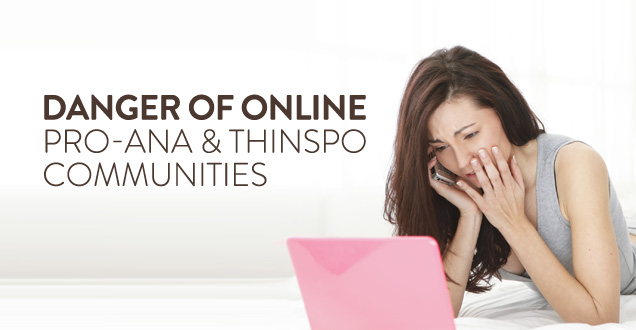
Many adults recall the teen years as a time of drama and change, with experiences of peer pressure, disappointment, and social dilemmas. How would we have coped if we didn’t have a safe place to escape? Welcome to being a teenager in 2014. Bullying, approval-seeking and the “group-think” mentality are rampant and constantly accessible, thanks (or no thanks) to smartphones and tablets and the fact that most teenagers are “logged in” 24/7. Constant internet access, the ubiquitous message that looking “good” means being liked, and the inescapable onslaught of what everyone else is doing makes online communities such as Pro-Ana websites and thinspiration blogs easier to find and get hooked on than ever before.
Being a teenager or young adult is a tough time in any era, but today teens are even vulnerable bullying and other types of victimization in the privacy of their own homes through their computer screens and smartphones. It is easy to understand why a teen would try to escape into an online community where he or she can feel accepted or believe he or she is being offered an actionable solution. In a society that encourages appearance changes as a route to happiness and promotes countless visual images of bodies, websites that promote extreme eating, dieting and exercise behaviors fit in perfectly.
But rather than promoting physical or mental health, strength and fitness, appropriate professional help, or even resiliency or social justice, Thinspo, Pro-Ana, and Pro-Mia sites and communities promote extreme and unhealthy thinness as the ultimate goal of being both beautiful and happy. According to the study by Dr. Emma Bond from the University Campus, Suffolk, titled “Virtually Anorexic – Where’s the Harm?” the dangers of these communities are that “[t]hey normalize emaciated bodies and promote unhealthy body images.” This creates a gateway to eating disorders as individuals bond via social media groups dedicated to destructive and even deadly behaviors. Even if teens or young adults don’t have eating disorders when they find these sites, it may not take long for them to start questioning their weight and their worth. Initially the information appears to mesh with the public health messages of anti-obesity, fitness and good nutrition that are taught at home and in school. But taken to the extreme, or used as an escape from painful life experiences, these messages can lead to unnecessary fear of food and eating, inappropriate compensatory measures, and unflattering comparisons with images of malnourished or computer-generated individuals. Mature adults are not immune to societal appearance norms, judgment and pressure. How much more susceptible are teens, with their not yet matured senses of self, to the misconception that extreme thinness equals “perfection” and should be the norm if they want to be happy and considered a beautiful, worthwhile person?
It is easy to understand how teens who are bullied or feel excluded online or in real life can fall prey to the false friendship and camaraderie of Pro-Ana or Pro-Mia websites., According to Dr. Bond’s study, “Through the performance of perfection, the users of pro-ED (eating disorder) sites achieve self-identity as an eating disordered person and group identity as belonging to the online cultural group.”
These teens find a (false) sense of protection and a common bond among other teens in the group who have eating disorders because most of the comments are encouraging and supportive. Unfortunately, some of these sites in fact target teens looking for a place to belong. The teens can be called “recruits” and are offered “secret” diets and tips, as well as strategies to avoid detection by parents and other adults. Some “former” Pro-Ana recruits have been speaking out about their stories, including “Courtney’s” article titled “It Happened to Me: I Was a Member of Pro-Ana Groups on the Internet”. She wrote about the constant struggle of thin as the “salvation,” and how it all started because she “wanted an outlet” and “a way to share [her] words with a secret identity so [she] wouldn’t be mocked.” Courtney found her salvation through the “twisted sisterhood” of “angels of Ana.” The sisters shared their thinspiration photos, which typically consisted of full-body shots that focused on the clavicle, chest and collarbones. The Pro-Ana sisters insisted that they weren’t freaks but beautiful women who “helped each other’s harm.”
Like most addictions — and Casa Palmera treatment center considers and treats eating disorders in many ways as addictions —Courtney found that removing herself from Pro-Ana participating is a process that has to be taken one day at a time. Courtney said she still doesn’t feel like an inspiration, but she’s proud of herself nonetheless and is grateful to have reached a point where she is no longer sinking.
There are ways to help young people like Courtney and to prevent this from happening to friends and loved ones. Make sure to check back on our website to read the next blog post of how to combat the Pro-Ana trend and its dangers. And if you are concerned about your own or a loved one’s eating or exercise behaviors, including resistance to recovery exacerbated by damaging website communities, please call Casa Palmera recovery center near San Diego, California at 866-768-6719. Our phones are answered 24 hours, 7 days a week, and we are happy to help you connect with the help you are seeking.




